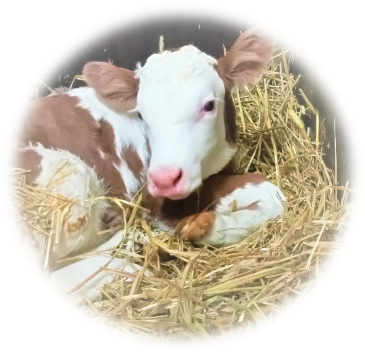
https://ec.europa.eu/eip/agriculture/en/find-connect/projects/bovine-beef-innovation-network-europe
Vitality is an important criterion in newborns. Because vital animals take in colostrum more quickly. The colostrum supply after birth has a strong influence on how healthy and productive a calf becomes.
In developed countries, human pre and post-natal care programs have resulted in a very high rate of success for prevention of problems in newborn babies. Part of this success is due to a standard requirement for the completion of a health and vigor score within minutes of birth. This method of assessment is commonly termed the Apgar score. It has become the standard procedure used for human newborns. In this assessment, five easily observed signs in newborn babies are evaluated. These signs can be assessed without special equipment and taught to delivery room personnel without difficulty. They comprise heart rate, respiratory effort, reflex irritability, muscle tone, and skin color. Tests of newborn vigor have been developed for other species including pig, horse and dog. In each of these studies, a modified Apgar score was created; choosing a few parameters that were easily evaluated without the use of advanced equipment (Murray, C.F. Leslie, K.E., 2013). It has been shown that animals with lower scores are slower to stand (piglets) or had a higher mortality (dogs) (Mee, J.F., 2008).
For calves, there have already been different attempts to develop such a score but so far, no uniform result has been found. Proposed parameters for scoring vitality in new born dairy calves are for example respiration, hair coat appearance, no peripheral edema, mucous membranes, response to reflex stimulation, muscle tone, heart rate, rectal temperature, sternal recumbence, attempts to rise, suckling (Mee, J.F. 2008). .
 There are parameters that can be assessed without touching the calf. These parameters are therefore suitable for all kinds of cattle and husbandry. Time until head lift should be three minutes, sternal recumbence should be reached five minutes after birth and after 20 minutes there should be the first attempts to stand. One hour to 90 minutes after birth calves should be able to stand spontaneously and at least 4 hours after birth the calve should start to suckle (Mee, J.F., 2008).
There are parameters that can be assessed without touching the calf. These parameters are therefore suitable for all kinds of cattle and husbandry. Time until head lift should be three minutes, sternal recumbence should be reached five minutes after birth and after 20 minutes there should be the first attempts to stand. One hour to 90 minutes after birth calves should be able to stand spontaneously and at least 4 hours after birth the calve should start to suckle (Mee, J.F., 2008).
These parameters should be observed especially after difficult birth and caesarean sections. Calves that deviate from these values need help. You should assist with colostrum intake. Maybe the Madigan Squeeze is also interesting here (see Dummy Calves).
Photo: Newborn Calf (C) von Deylen
Easily observed signs, evaluated without the use of advanced equipment, easy to be taught can save lives!
Literature:
- Murray, C.F. Leslie, K.E. (2013): Newborn calf vitality: risk factors, characteristics, assessment, resulting outcomes and strategies for improvement;
- Mee, J.F. (2008): Managing the calf at calving time
- Murray, C. F. (2015) The effect of dystocia on physiological and behavioral characteristics related to vitality and passive transfer of immunoglobulins in newborn Holstein calves
- Report on demonstration in Belgium: https://hub.bovine-eu.net/new-born-calves-suckler-farms/demonstration-scoring-vitality-in-newborn-calves-belgium
- Report on demonstration in France: https://hub.bovine-eu.net/new-born-calves-suckler-farms/demonstration-scoring-vitality-in-newborn-calves-france
- Report on demonstration in Portugal: https://hub.bovine-eu.net/new-born-calves-suckler-farms/demonstration-scoring-vitality-in-newborn-calves-portugal
- Report on demonstration in Estonia: https://hub.bovine-eu.net/new-born-calves-suckler-farms/demonstration-scoring-vitality-in-newborn-calves-estonia
This Research Innovation has an Impact on:
- Animal health and welfare: The set up of a modified Apgarscore for calves can help to promote a better start to life for weak calves or even safe their lives. Thus it will definitely improve the animal health and welfare of suckler calves.
- Production efficiency and meat quality: Early colostrum intake is important for the calves' immune system. Making an early decision regarding support for colostrum intake can affect the calf's entire life and thus its fattening performance.
Hier klicken, um den Artikel auf Deutsch zu lesen.